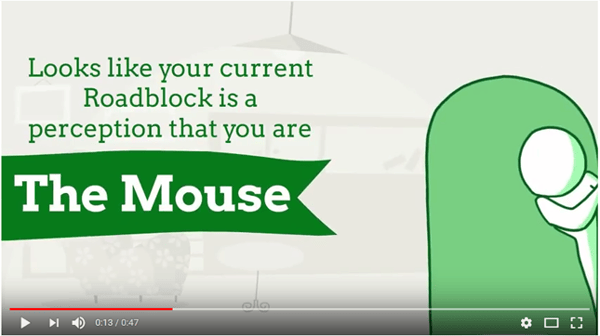Warning Signs of Toxic Leadership Part 9: Conflict Avoidance at Work
This 12-part series on the warning signs of toxic leadership is, admittedly, very pointed. It’s intended to challenge you. This week's toxic persona is that of the leader who practices conflict avoidance at work.
If you’ve bristled while reading descriptions of the personas featured in this series, good. We want people to get a little bit uncomfortable. Defensiveness is often a clue that you need to look a little closer.
Why do we want to make you uncomfortable? Only for your own awareness and understanding. Hopefully, you will do something with that awareness. Don’t justify your behaviors and attitudes. Modify them so you can be more effective. Acknowledge them so they are no longer blind spots. (By the way, they’re only blind spots to you – everyone else sees them plainly!).
In this uncomfortable space, remember that you’re not alone. Over 90% of people have experienced these 12 career roadblocks in some form. They are all manageable once you decide to work on them. We can help.
Related posts:
- Part 1: The Scrambler
- Part 3: The Climber
- Part 4: The One-Hit Wonder
- Part 5: The Intimidator
- Part 6: The High & Mighty
- Part 7: The Lone Wolf
- Part 8: The Nuclear Reactor
- Part 10: The Control Freak
- Part 11: The Artful Dodger
- Part 12: The Rebel
Warning Signs of Toxic Leadership: Are You The Mouse?
Tentative. Hanging in the background. Cautious. You’re not someone who seeks the limelight or takes risks. You’d prefer to leave the decision-making to someone else.
Whether real or perceived, you may be seen as The Mouse who:
-
Is timid about raising concerns or voicing your own opinion.
-
Has a fear of conflict in the workplace and is not assertive about getting your own needs met.
-
Lacks confidence and requires too much validation and approval.
-
Can’t make decisions and work autonomously; is paralyzed by fear of failure.
-
Is a highly risk-averse manager, for fear of a failure reflecting badly on you.
In the past, this has served you well or manifested as a positive when:
-
You’ve avoided rework and errors.
-
Accountability for errors and decisions has been shared rather than yours to bear alone.
-
You’ve dodged heated conversations or uncomfortable disagreements.
-
You wanted a boost in confidence and get others to approve or validate your work.
-
Being promoted or given new responsibilities was not a desired outcome.
Maybe this persona isn’t who you really are. It’s not who you intend to be. It feels unfair to be labeled this way. Nonetheless, if people see you as The Mouse, something caused them to see you this way. For them, this is real.
What Can I Do if I Might Be The Mouse?
Make sure you don't have a blindspot when it comes to your soft skills or style. Take the free, self-paced course called The Essentials of Personal Effectiveness to build transferable skills and improve the quality of workplace interactions.
If you’re encountering a potential blind spot, feel stalled in your career, or are struggling with interpersonal skills in the workplace, you might benefit from working with a certified executive coach. Most senior-level executives have worked with a professional coach at some point in their career. Check out this Forbes article for more about the benefits of coaching.
Ultimately, YOU are responsible and YOU are in control of your choices about how to lead and how to interact with others in the workplace. Now that you’ve got awareness, it’s time to take action.
If you are, indeed, The Mouse, here are some immediate actions you can take to change others’ perceptions and exhibit these behaviors less frequently.
-
Demonstrate independence decision making and an ability to work autonomously.
-
Seek others’ approval and assurances less frequently so you won’t seem so needy.
-
Give yourself permission to fail, learn, grow and try again. Perfection is not attainable.
-
Push yourself outside your comfort zone and be willing to take incremental risks.
If you’re wondering whether or not it’s worth it to make these changes, you should know that there is an impact to being perceived as The Mouse. There’s an impact on people you work with.
There are also consequences for you, including:
-
The biggest risk you take when you allow Mouse behaviors to go unchecked is that people will believe you can’t be trusted with more responsibility. It’s very difficult to have confidence in someone who does not display self-confidence.
-
When you hesitate to act, express apprehensions or are afraid of conflict, it appears that you can’t or won’t be able to work independently. When you show disproportionate fear about making small decisions, others determine that you can’t handle bigger ones. Your unwillingness to make small mistakes holds you back.
-
You also run the risk of being overlooked at every turn. If you’re not being more assertive and expressing your needs, people will assume you don’t have any. The more you hold back your voice, the less voice you will have. No matter how talented you are, your timidity will conceal the contributions you could make.
This choice is yours whether to stop avoiding conflict. Choosing to deny, ignore or embrace your Career Roadblock characteristics are all legitimate choices. You don’t have to change a thing.
On the other hand, if these behaviors or perceptions are preventing you from reaching your goals, it’s also a legitimate choice to modify what you’re doing.
Either way, put yourself in control. Be aware of the perception, your choices surrounding that perception, and the impact of being perceived in this way.
How Can I Learn More About This Roadblock (and Others, Too)?
The Mouse is one of 12 behavior sets that can become career roadblocks. When others are observing the issues with someone who is stuck and has these blind spots, they frequently use terms to describe these roadblocks (e.g. “control freak” or “dinosaur”).
You can learn about all the career roadblocks that lead to toxic leadership by following this blog series.


